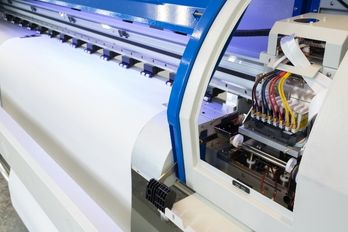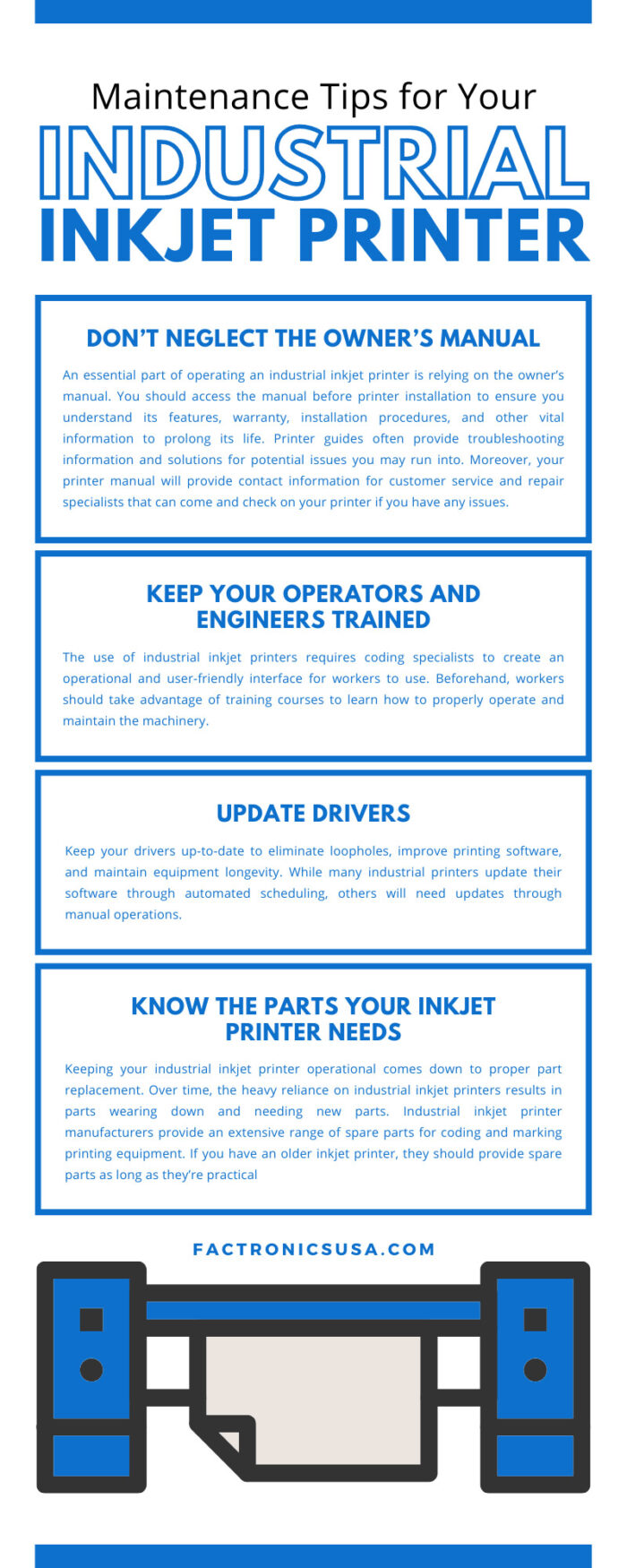
Equipment maintenance and sustainability help keep workflow and productivity afloat. Standard printers don’t cut it when it comes to warehouse and manufacturing work, so businesses must rely on industrial inkjet printers for food and beverage, pharmaceutical, and cosmetic label printing. After investing in an industrial inkjet printer, it’s crucial that you understand the maintenance required to keep it operational.
Inkjet printing technology has become more significant than direct printing or marking. They serve multiple purposes, such as printing lot numbers, bar codes, and batch and expiration dates. So let’s review the seven industrial inkjet printer maintenance tips to keep your equipment in top shape.
What Is an Inkjet Printer?
So what is an inkjet printer, and how do they operate? They are a low-cost, relatively quick, and reliable method for printing alphanumeric and graphic information with complex technology. The operation of an inkjet printer works as such: a pattern of tiny ink droplets come ejected from a printhead onto a specific substrate, all without touching the surface. They create characters or graphics through different ink dots precisely placed on the substrate.
There are numerous benefits to industrial inkjet printing, such as switching from analog to digital processing, reducing manufacturing costs and inventory, printing on numerous-sized surfaces, higher quality output, and more. Additionally, industrial inkjet printers can work on various surfaces, from fragile to uneven, while maintaining high-quality prints.
Types of Industrial Inkjet Printers
There are several significant types of inkjet technologies that industrial printer manufacturers use: CIJ, or continuous ink jet, Piezoelectric, and Thermal Bubble. CIJs contain two liquids: an ink and a solvent. The two liquids are fed into a larger tank, where it becomes a pressurized mixture and then fed into the printhead. Piezoelectric elements then create ink droplets through oscillation, propelling them toward the nozzle’s substrate. At the same time, electrical charges get delivered to the drops, and non-charged drops get sent back to the main tanks.
Piezoelectric, also known as Piezo Print Heads, offers high-quality prints using an electric charge paired with piezo crystals. They spray the various inks through user commands behind the nozzle’s ink reservoir.
As a result, inward electronically charged vibrations produce small amounts of ink, while outward vibrations retract the ink back into the reservoir to replace sprayed ink. Thermal Bubble jet systems create small ink bubbles sprayed from a nozzle via print head onto chosen media. The heat vaporizes ink into bubbles and then expands and bursts out of the nozzle. It will create and spray bubbles rapidly in a simultaneous method.
Maintenance Tips for Inkjet Printers
Once you’ve invested in the appropriate industrial inkjet printer, it’s crucial that you understand the maintenance behind its operation. The last thing you want is your printer to stop working and need expensive repairs suddenly.
Don’t Neglect the Owner’s Manual
An essential part of operating an industrial inkjet printer is relying on the owner’s manual. You should access the manual before printer installation to ensure you understand its features, warranty, installation procedures, and other vital information to prolong its life.
Printer guides often provide troubleshooting information and solutions for potential issues you may run into. Moreover, your printer manual will provide contact information for customer service and repair specialists that can come and check on your printer if you have any issues.
Keep Your Operators and Engineers Trained
The use of industrial inkjet printers requires coding specialists to create an operational and user-friendly interface for workers to use. Beforehand, workers should take advantage of training courses to learn how to properly operate and maintain the machinery.
Training engineers, meeting production line personnel, and knowing what to do in unfavorable situations help keep your team educated while keeping the industrial inkjet printing machinery optimal. After taking the specific courses, employees should receive certifications to operate and maintain marking and coding industrial printers.
Update Drivers
Over time, your industrial inkjet printer will need system updates to stay operational. Out-of-date software can result in glitches, corruptions, and lower-quality results for your printing projects. Secondly, it can effectively slow down progress and productivity.
Keep your drivers up-to-date to eliminate loopholes, improve printing software, and maintain equipment longevity. While many industrial printers update their software through automated scheduling, others will need updates through manual operations.
Know the Parts Your Inkjet Printer Needs
Keeping your industrial inkjet printer operational comes down to proper part replacement. Over time, the heavy reliance on industrial inkjet printers results in parts wearing down and needing new parts.
Industrial inkjet printer manufacturers provide an extensive range of spare parts for coding and marking printing equipment. If you have an older inkjet printer, they should provide spare parts as long as they’re practical. Avoid using third-party parts, so your industrial printer can operate at maximum quality and performance.
Turn Off When Not in Use
While you use your industrial printer repeatedly at work, it’s crucial that if not in use, you turn it off. Continuous inkjet printers run the self-cleaning process normally during the shutdown process. Thermal inkjets don’t self-clean at shutdown, so it is important to use the cartridge covers while not in use.
If these procedures are not followed, printer heads or cartridges can become clogged, resulting in other parts being damaged. So ensure you use your printer regularly and shut it off when not in use. Because many workplaces use industrial printers daily, you must work hard to maintain their lifespan.
Schedule Maintenance
Heavy use of industrial inkjet printers results in regular schedule maintenance after a certain period of time. Depending on the industrial printer you have and the level of usage needed, industrial printing technology comes designed to remind you when services are due.
From there, you can plan accordingly and schedule their routine maintenance. Ensure that you contact your industrial printer distributor to schedule routine maintenance so that you can continue using your inkjet printer.
Do you need an industrial inkjet printer that will do the job well? At Factronics USA, you can depend on us for high-quality inkjet products. Our line of industrial inkjet printers will deliver a low total cost of ownership, increase production output, and provide easy coding and marking solutions. Our inkjet products have easy self-guided operation and service, hassle-free operation, and affordability. Ask about our industrial products today to get started.

